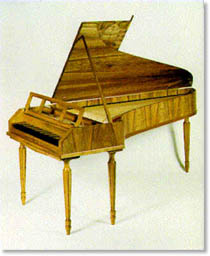After
Johann Andreas Stein (1784)
Now Retired
 For over twenty-five years it has been generally accepted that
the only appropriate instruments for the performance of renaissance and baroque music are
replicas of instruments made during the period. Few musicians today would consider
representing the modern piano as the instrument most suited to the rococo writing of
Duphly or Scarlatti. But only relatively recently has it begun to be conceded that the
keyboard literature of the late 18th and early 19th centuries was written specifically for
the fortepiano and is not ideally suited to the modern piano. The brilliant keyboard
literature composed between 1765 and 1825 by the descendants of Bach, by Clementi, Hummel,
Field, Mehul, Paesiello, Cherubini and many others is hardly known to modern audiences, a
loss due in large measure to the lack of appropriate instruments for performance. Even the
perfunctory deference accorded the keyboard works of Haydn and Mozart has not resulted in
the frequency of performance or the pleasure of response this music deserves. Just as
baroque music achieves its true color and splendor when played on the harpsichord, so does
the classical literature acquire its natural brilliance and grace when played on the
fortepiano. The ideal instrument for this music is the Viennese fortepiano of the type
made by J. A. Stein, a maker whose instruments were the particular favorites of Mozart and
the young Beethoven.
For over twenty-five years it has been generally accepted that
the only appropriate instruments for the performance of renaissance and baroque music are
replicas of instruments made during the period. Few musicians today would consider
representing the modern piano as the instrument most suited to the rococo writing of
Duphly or Scarlatti. But only relatively recently has it begun to be conceded that the
keyboard literature of the late 18th and early 19th centuries was written specifically for
the fortepiano and is not ideally suited to the modern piano. The brilliant keyboard
literature composed between 1765 and 1825 by the descendants of Bach, by Clementi, Hummel,
Field, Mehul, Paesiello, Cherubini and many others is hardly known to modern audiences, a
loss due in large measure to the lack of appropriate instruments for performance. Even the
perfunctory deference accorded the keyboard works of Haydn and Mozart has not resulted in
the frequency of performance or the pleasure of response this music deserves. Just as
baroque music achieves its true color and splendor when played on the harpsichord, so does
the classical literature acquire its natural brilliance and grace when played on the
fortepiano. The ideal instrument for this music is the Viennese fortepiano of the type
made by J. A. Stein, a maker whose instruments were the particular favorites of Mozart and
the young Beethoven.
The classical fortepiano differs from the modern piano in
the lightness of its construction and stringing as well as the principles underlying its
action. The tone color is easily identifiable as a piano but lighter, thinner and more
transparent, less emphatic and sustained. Articulation and phrasing are more easily
perceived. The shallower and lighter action demands and develops a crisper style of
performance which is inherently appropriate to the music of the period. The original
pedalings as well as effects such as szforzando and subito piano acquire new
significance when executed on the fortepiano and one is not left wondering what otherwise
good musicians, such as Mozart and Beethoven, had in mind when indicating their use.
Our fortepiano is a careful replica of a Stein instrument
of 1784 and closely reproduces the tone and action as well as the details of construction
of this early piano. It is offered with its case and lid veneered in cherry or walnut. The
instrument stands on turned and fluted legs of the same species. Two lid options are
available at additional cost. The lid, flap and fallboard can be supplied constructed from
solid wood in the traditional frame and panel manner which nicely mirrors the shape of the
instrument on the underside of the lid. A more opulent treatment of the lid, flap and
fallboard is to veneer the exterior of these parts in a diamond marquetry pattern.
Announcement
I wish to thank you for your interest in our Viennese fortepiano. I regret to announce that, after 30 years of its availability, I have become convinced of our need to retire this instrument from production. It is a very simple matter. The amount of activity for this design recently has dwindled to the point where it is no longer particularly profitable to produce and yet keep affordable. In contrast to our harpsichord offerings, it demands both different stocks of wood, material and parts (much of which must be stored ahead, some at the risk of spoilage), as well as a markedly different skill set. Consequently the difficulty in scheduling work and producing a satisfactory product has passed my tipping point and I have reluctantly made the decision to terminate the fortepiano's availability. I would prefer we do things well rather than otherwise. We will, of course, continue to support and repair existing kits and finished instruments. If you wish to inquire further about finished fortepianos (or kits) or explore possibilities, please feel free to contact me at finfo@hubharp.com.
Hendrik Broekman
